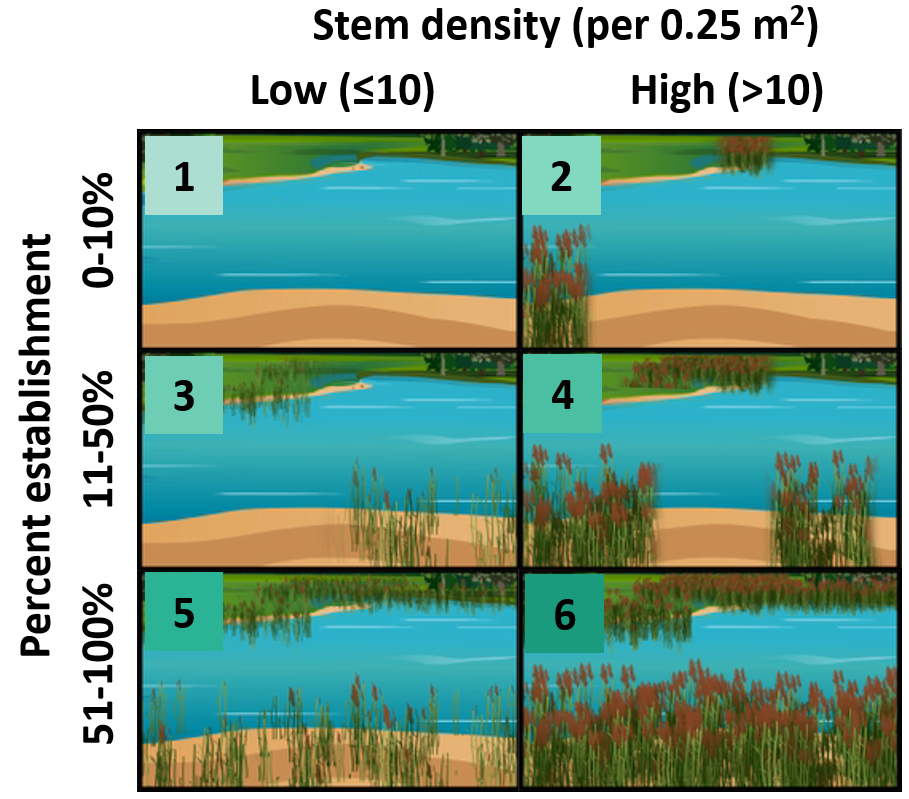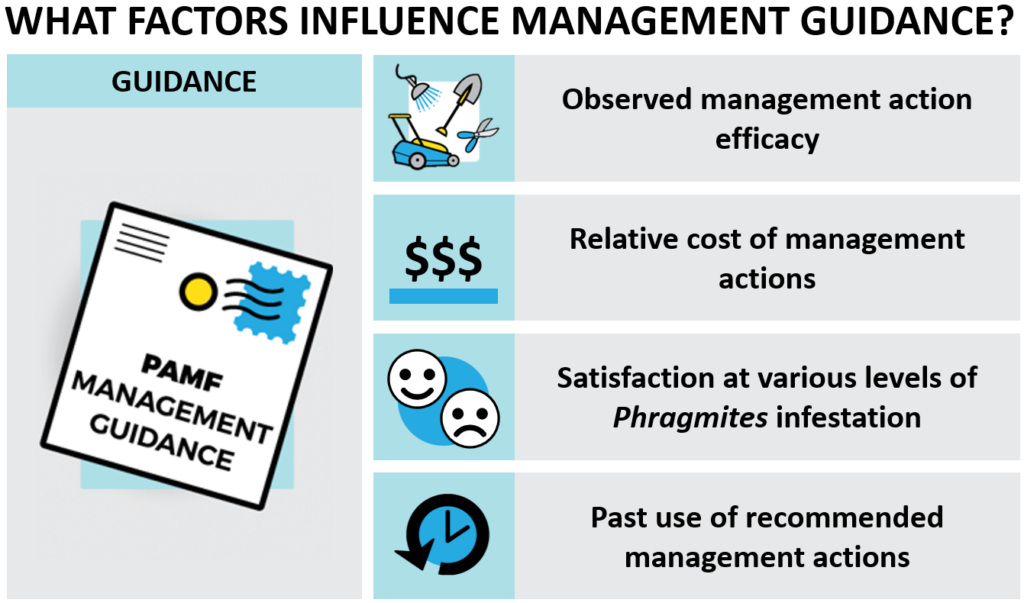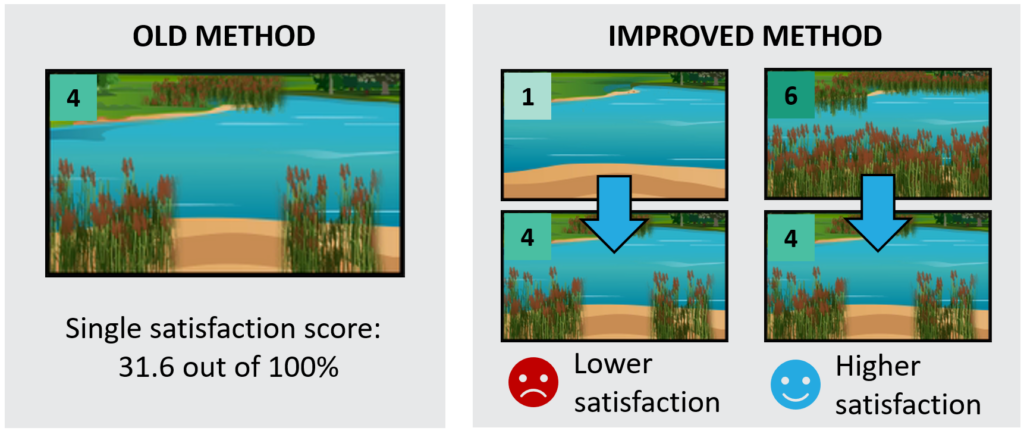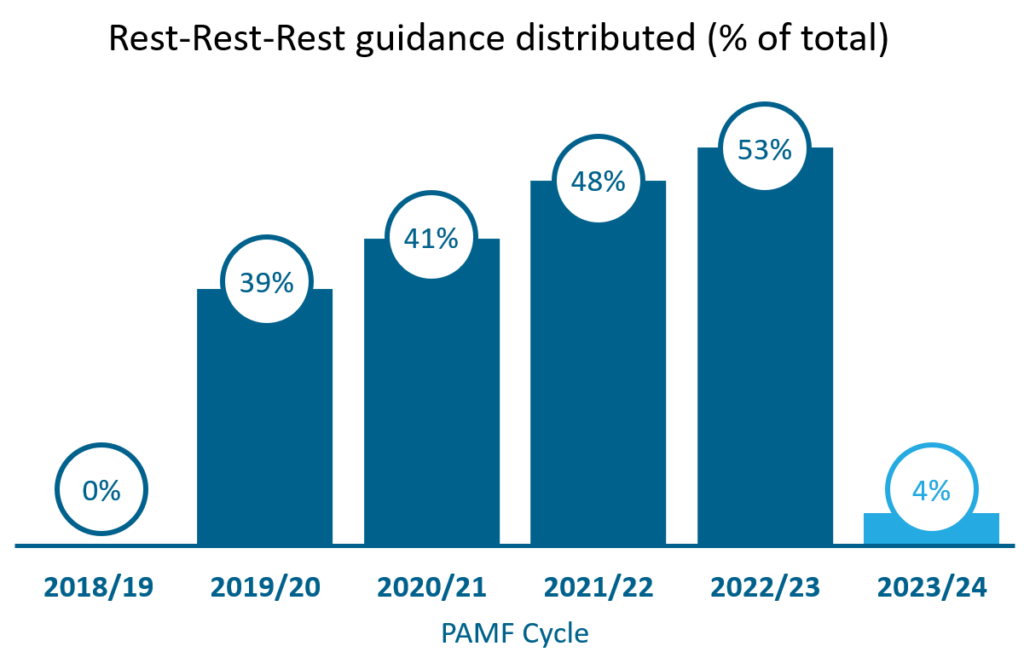September 6, 2023 – Taaja Tucker-Silva, Great Lakes Commission
The Phragmites Adaptive Management Framework (PAMF) provides participants with site-specific management guidance every year based on the latest Phragmites management data collected from around the Great Lakes basin. This guidance is generated by the PAMF predictive model annually in August (watch a video about the PAMF Model here!). Over the past few years, the guidance produced by the PAMF Model included increasing recommendations for managers to “Rest-Rest-Rest” (or do nothing) throughout the year, even at sites with robust Phragmites populations. Managers typically want to remove Phragmites, so why does the Model recommend “resting” over alternative management strategies? Today we’ll answer that question and explain how we’ve improved the PAMF Model to produce management guidance for 2023/2024—and beyond—with less Rest!
How the PAMF Model works
We need to dig into the inner workings of the PAMF Model to understand the prevalence of Rest in past management guidance. The primary influence on the Model’s guidance is observed management combination efficacy, or which combination of management techniques implemented over the course of translocating, dormant, and growing biological phases the work best to reduce Phragmites infestations. We categorize Phragmites infestations at management units into six invasion states ranging from low to high infestation (Figure 1) and determine a management combination’s efficacy by looking at the probability that a management unit will transition from one invasion state to another. For example, if a manager uses combination A to reduce the management unit’s invasion state from 6 to 1, we consider it a more effective technique than combination B that only reduces the invasion state from 6 to 4.
 Figure 1. The six invasion states used in the PAMF Model. Invasion state is determined through yearly monitoring.
Figure 1. The six invasion states used in the PAMF Model. Invasion state is determined through yearly monitoring.
While the guidance the PAMF Model produces is based heavily on the observed efficacy of different management combinations, it also considers three other factors (Figure 2): the relative cost of the different management actions, a measure of managers’ satisfaction with different levels of Phragmites infestation, and how likely a manager is to implement a given management action based on past use of recommended management actions (i.e., if the Model recommended an action and no one used it, it is less likely to recommend that action in the future).
 Figure 2. The four components that the PAMF Model weighs when producing management guidance.
Figure 2. The four components that the PAMF Model weighs when producing management guidance.
Considering all four factors, the Model produces not only “optimal” guidance—what the PAMF Model determines to be the optimal combination of all four factors—but also “near-optimal” guidance which is predicted to be similar in performance. PAMF participants receive both optimal and near-optimal guidance. “Rest-Rest-Rest” was frequently recommended as optimal guidance, although clearly not managing is considered not very optimal to participants. Why then was it recommended?
“Rest is best”
“Rest-Rest-Rest” is included as a management combination for three key reasons: 1) we need a reporting option for participants to submit data even if they aren’t able to get out and manage for one reason or another, 2) we need a guidance option for when Phragmites has been eradicated and there is simply none left to manage but participants wish to keep monitoring, and 3) because we want to learn more about how Phragmites responds when it is not managed. For example, does Phragmites bounce right back after a year of no management, does it slowly creep back in, or does it remain unchanged? This is valuable information we need to fully understand Phragmites population dynamics.
While it makes sense to include “Rest-Rest-Rest” as an option when submitting management reports, it may not be apparent why “Rest-Rest-Rest” is recommended by the Model as guidance, but there are several explanations for this. First, resting doesn’t cost money! Because the Model considers cost in its optimization, Rest may sometimes kick another management combination out of the top spot simply due to its low cost. Second, some management units are restricted in which management actions they can implement due to regulations or site conditions. In cases where managers can’t use herbicides (Glyphosate, Glyphosate+, or Imazapyr), Flood, or Cut Underwater management techniques, the Model is limited in the actions it can recommend and will frequently recommend Rest because the alternative combination includes Spading, which is quite time-intensive and therefore costly. Third, using Rest instead of other management actions recommended by the Model could have had a minor impact on future guidance. For example, a manager may have been provided with guidance to treat Phragmites with herbicide, but because they did not have the funding to do so, they did not manage the unit, which led the Model to believe that Rest may be preferred in some cases. Lastly, at very low invasion states (e.g., Phragmites is eradicated or is present in very low densities), it might not make sense to continue to treat Phragmites. In fact, when Rest was first often recommended as optimal guidance, it was primarily for management units with lower levels of Phragmites infestation. However, over time the prevalence of optimal Rest recommendations increased in sites with higher infestation rates, and the primary cause was determined to be the Model-influencing factor that we haven’t talked about yet: satisfaction.
(Managers can’t get no) Satisfaction
In PAMF, satisfaction refers to how satisfied a manager is with a given invasion state on a scale of 0-100%. We collected expert-elicited rankings of satisfaction from our Technical Working Group during PAMF’s developmental phase. Satisfaction is intuitive: as Phragmites invasion state decreases, satisfaction increases, and as Phragmites invasion state increases, satisfaction decreases (Figure 3).
 Figure 3. Satisfaction and its relationship with the six invasion states of Phragmites used in the PAMF Model.
Figure 3. Satisfaction and its relationship with the six invasion states of Phragmites used in the PAMF Model.
Satisfaction, together with cost, is part of the PAMF Model’s reward function. Management combinations with higher rewards (low cost and high satisfaction) are considered more optimal. The problem with this form of satisfaction is there is a just a single value tied to each invasion state, and it does not consider how satisfied a manager would be if a management unit transitioned to or out of that invasion state. As of 2023/2024, we have incorporated satisfaction associated with these transitions into the Model by soliciting new data from an expert panel. To understand the difference between the old and new methods of using satisfaction, consider this example of a hypothetical management unit in invasion state 4 (Figure 4).
 Figure 4. Example of how satisfaction in the PAMF Model worked under the old method and the new, improved method for a management unit in invasion state 4.
Figure 4. Example of how satisfaction in the PAMF Model worked under the old method and the new, improved method for a management unit in invasion state 4.
Under the old method, a management unit in invasion state 4 had a single satisfaction score, and the circumstances under which the management unit came to be in state 4 had no relevance to the Model. Under the improved method, a management unit would have a lower satisfaction score if Phragmites grew and the invasion state increased from state 1 to state 4, and likewise would have a higher satisfaction score if Phragmites was reduced and the invasion state decreased from state 6 to state 4.
So what?
You might be wondering, “Sure, this sounds better, but what does this have to do with Rest?” Consider the example in Figure 4, where the invasion state increased from state 1 to state 4. By assigning a lower satisfaction in that case, we are penalizing an increase in invasion state, and therefore reducing the likelihood of the Model recommending management combinations that result in Phragmites growth rather than reductions—such as “Rest-Rest-Rest.”
Moving forward
We improved the Model in time to produce 2023/2024 management guidance. The number of “Rest-Rest-Rest” guidance recommendations decreased from a high of 53% of all optimal recommendations to just 4% (Figure 5). We hope that PAMF participants find the updated Model guidance useful and will promote increased participation in PAMF.
 Figure 5. The percentage of all optimal guidance distributed to participants that had “Rest-Rest-Rest” as the optimal management combination across each PAMF cycle.
Figure 5. The percentage of all optimal guidance distributed to participants that had “Rest-Rest-Rest” as the optimal management combination across each PAMF cycle.
We couldn’t do it without you!
Participant feedback helped us move this issue to the forefront and we encourage anyone participating in PAMF to let us know their thoughts in our annual survey that we have emailed to them—your opinion matters! We will continue to make improvements to PAMF, including the Model, to create the best participant experience possible.
Special thanks to our team of eight Phragmites managers and researchers who volunteered their time to take part in the expert elicitation exercise this year. Your efforts directly contributed to improving PAMF. Thank you! And let’s not forget PAMF participants. Participating managers receive management guidance and contribute to the collective learning process whereby all Phragmites managers in the Great Lakes region can benefit. Not yet a participant in PAMF? Join today!
